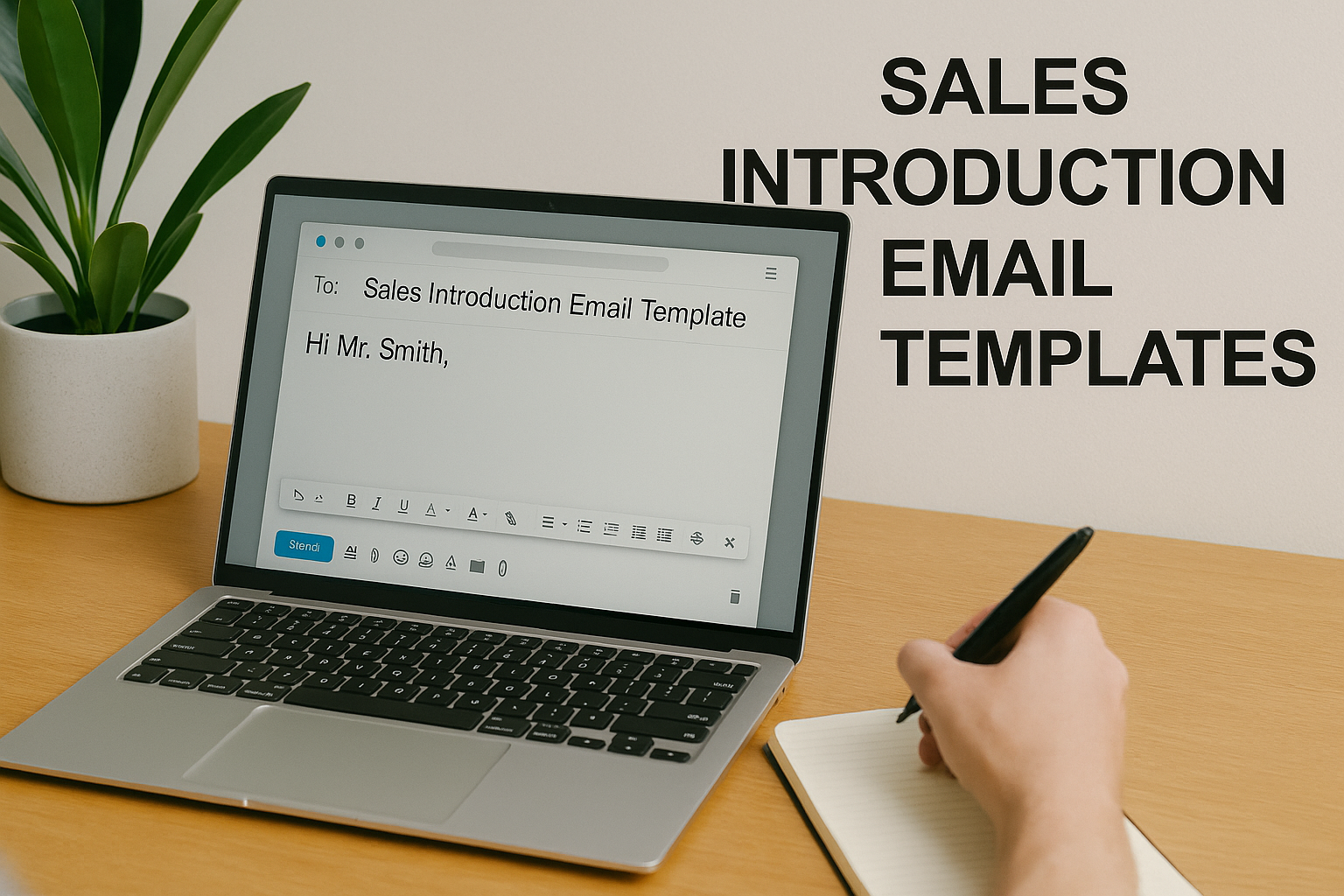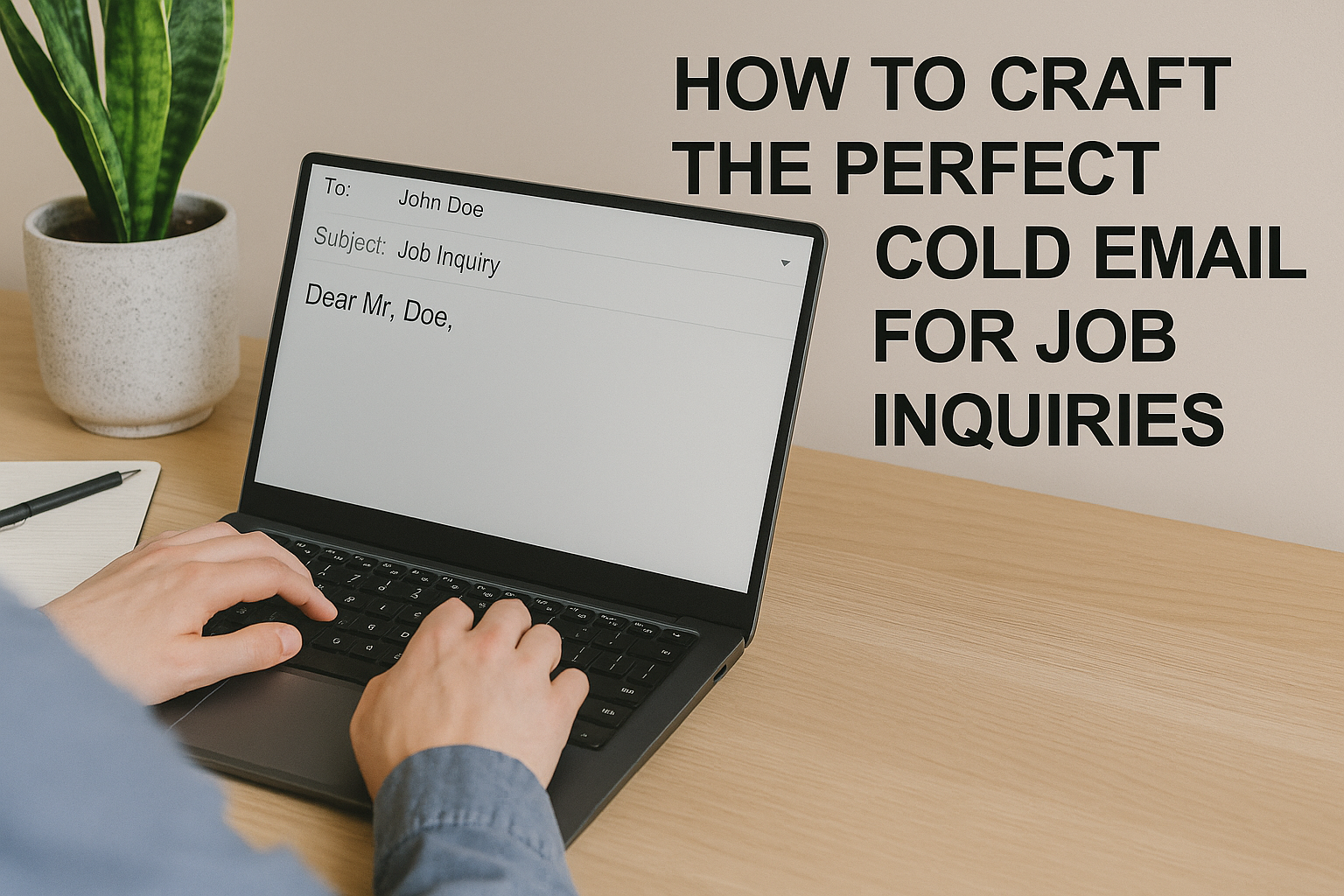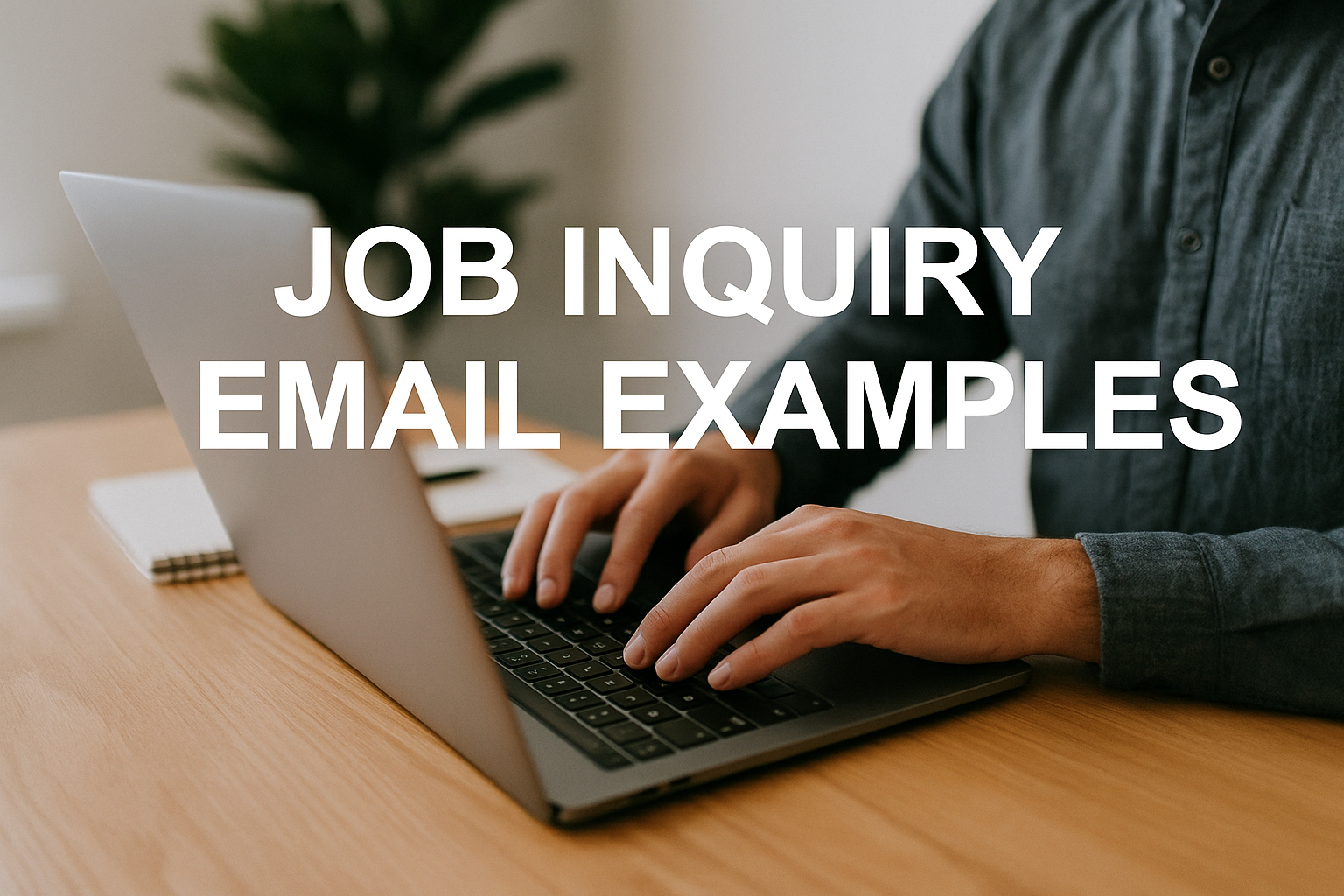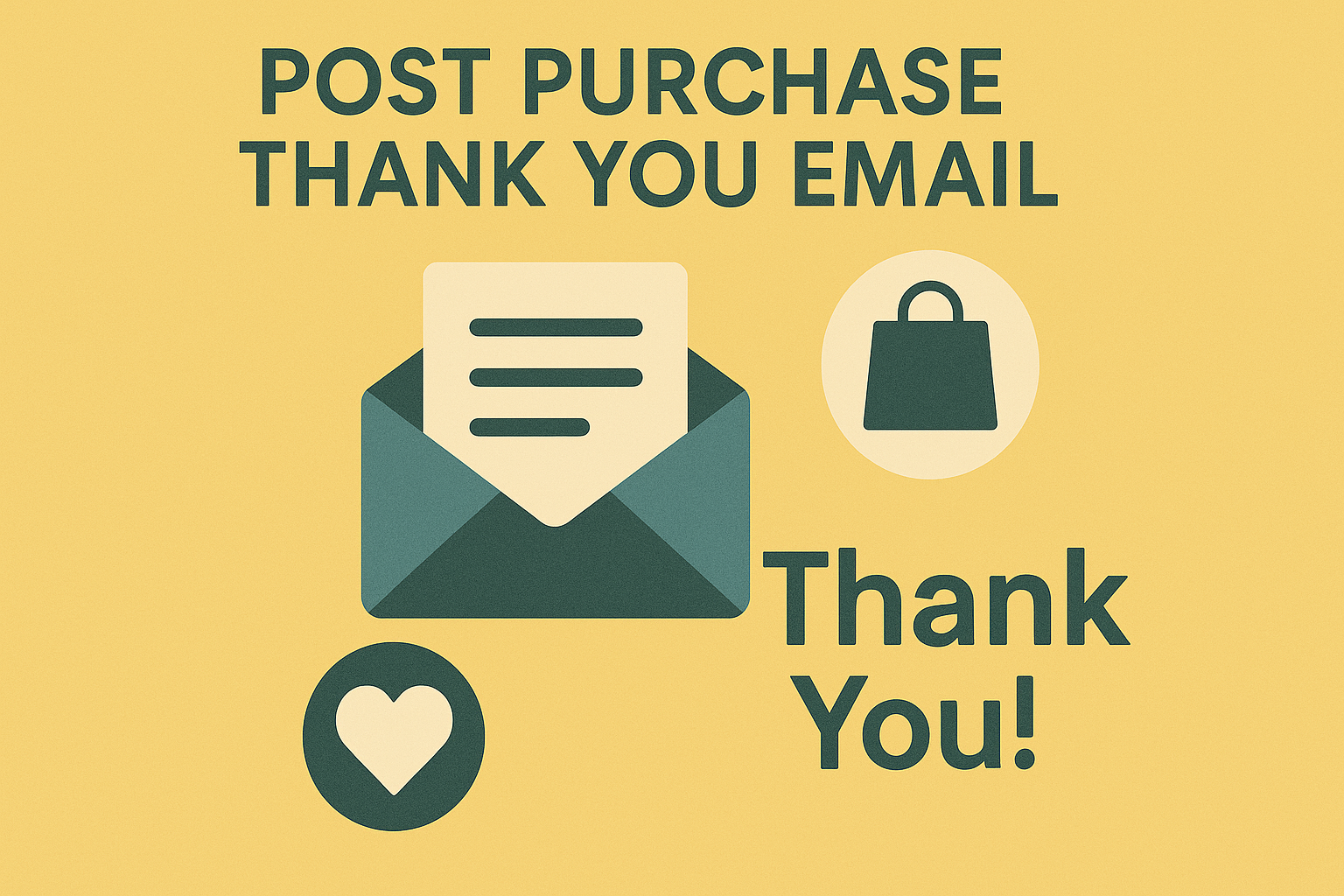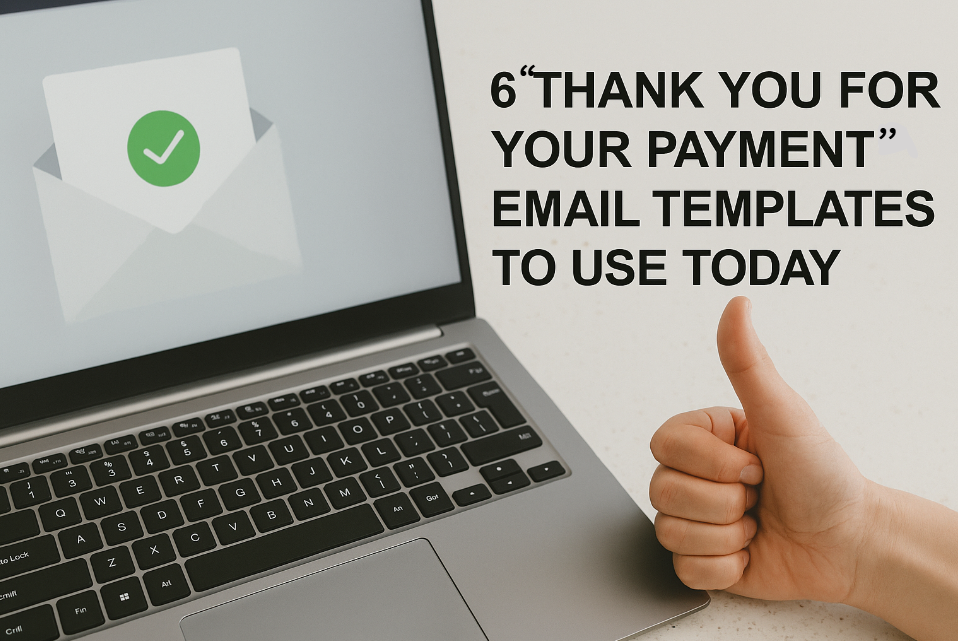15 Sales Introduction Email Templates for Maximum Engagement
Key Takeaways
-
A good sales introduction email is the opening move to forge connections with prospects and opens the door to further dialogue.
-
Personalization and value are going to get you opened, so personalize a lot more than just the name.
-
Timing is everything. I send introduction emails immediately after meetings, referrals, or a pertinent company event.
-
Employ clear subject lines and an organized layout so your messages don’t get lost in overstuffed inboxes and are simple to digest.
-
Use psychology such as reciprocity, curiosity, and authority to get replies and establish trust.
-
Keep adjusting your templates and outreach strategies by mining what works, what doesn’t, and common mistakes–fuzzy messaging, jabbering, and hard selling.
Starting a sales conversation isn’t easy—but the right email template can make it feel natural instead of awkward. A sales introduction email is like your digital handshake: short, clear, and designed to spark interest.
Templates give sales teams a proven structure to follow so every message stays on point, easy to scan, and focused on the prospect. Instead of staring at a blank screen, you’ve got a framework that highlights who you are, why you’re reaching out, and what the next step should be.
The result? Faster writing, higher reply rates, and emails that actually get read.
What is a Sales Introduction Email?

Think of a sales introduction email as your virtual handshake. It’s a short, personalized note you send to a potential client to kick off the relationship. The goal isn’t to close a deal right away—it’s to spark interest, build credibility, and open the door for future conversations.
By introducing yourself and your company in a clear, respectful way, you show the recipient that you value their time and understand their needs. The way you craft this first message shapes the prospect’s impression of you—your tone, professionalism, and attention to detail all shine through.
In other words, your intro email sets the stage. It gives the reader a quick preview of how you communicate and what kind of partner you’ll be moving forward. Done right, it’s the first step toward trust and a lasting business relationship.
15 Sales Introduction Email Templates for Maximum Engagement
An effective introduction email is like a well-rehearsed elevator pitch: it’s brief, friendly, and clearly about them, the reader. Inboxes are crowded (only ~30% of cold sales emails get opened, so your first lines must grab attention. Think of it as giving a quick but useful present – a helpful insight or compliment – before asking anything.
Below are 15 ready-to-use templates for various sales intro scenarios. Each is paired with a short “Why it works” note, so you can learn the principle behind the words.
1. Referral Introduction (Mutual Connection)

Subject: [Mutual Connection] thought we should connect
Hi [Name],
[Mutual Connection] mentioned that you’ve been looking into [area related to your service]. I’m [Your Name] from [Company], and we help organizations like [Prospect’s Company] save time on [specific task/problem].
For example, we recently helped [Similar Company] reduce [pain point] by 30% with our [product/service]. I thought this could be a quick win for you, too.
Would you be open to a brief call to discuss this?
Best regards,
[Your Name]
[Your Contact Info]
Why it works: Mentioning a mutual contact (and the prospect’s challenge) immediately builds trust and relevance. Referrals warm up cold outreach by supplying instant social proof. It also shows you’ve done some homework, making your email feel personal rather than random.
2. After a Networking Event (You Met in Person)

Subject: Great meeting you at [Event]!
Hi [Name],
It was a pleasure chatting with you at [Event] about [topic you discussed]. I enjoyed hearing about your role at [Prospect’s Company], especially your insights on [specific point].
I’m [Your Name] from [Company]. I recall you mentioned wanting to improve [related goal/pain]. We’ve helped similar teams streamline [task] with [our product/service], often cutting hours of work.
Could we schedule a quick call next week to explore this? No pressure at all – just thought it might be helpful after our chat.
Cheers,
[Your Name]
[Your Contact Info]
Why it works: This template picks up a real-world conversation. Referencing the event and topic personalizes the message and jogs the memory. It also conveys courtesy by recapping what you learned about them (“I enjoyed hearing about…”). This confirms it’s not a generic blast email and naturally leads into how you can help with their stated needs.
3. Cold Outreach (Curiosity / “Quick Question”)

Subject: Quick question about [Prospect’s Company]
Hi [Name],
I noticed [Prospect’s Company] is focusing on [recent initiative or goal]. I’m [Your Name] from [Company], and we specialize in helping businesses [achieve that goal] more easily.
For example, we recently helped [Client A] [benefit achieved]. If there’s even a chance you’re exploring solutions for [related problem], I’d love to share a couple of ideas.
Would you be open to a 10-minute call next week? If not, no worries – feel free to let me know.
Best,
[Your Name]
[Your Contact Info]
Why it works: The subject line “Quick question” promises brevity and piques curiosity. The opening line references something specific about the company to show you’ve researched them. By positioning yourself as someone offering ideas, not a hard sell, you lower defenses. The ask (“open to a 10-minute call… if not, no worries”) is polite and low-pressure, making it easy to say yes.
4. LinkedIn or Social Follow-Up

Subject: Following up on our LinkedIn conversation
Hi [Name],
Thanks for connecting on LinkedIn! I enjoyed your post about [topic] and thought you might be interested in how we helped a similar company with [benefit].
I’m [Your Name] with [Company]. We work in [industry or solution area] and have seen teams like yours reduce [pain point] by [x]%. I’d love to swap insights on [shared interest] and see if there’s a fit for collaboration.
Would you be open to a quick Zoom chat? Let me know what your schedule looks like.
Best regards,
[Your Name]
[Your Contact Info]
Why it works: This email builds on an existing online touchpoint, so it feels natural rather than out of the blue. Referencing the person’s content (a LinkedIn post) flatters them and shows genuine interest. It also establishes authority by hinting at industry success. The tone is conversational (“swap insights”), which makes the call invitation seem more like a friendly networking chat.
5. Value-First (Sharing a Tip or Resource)

Subject: A quick tip for [Prospect’s Company]
Hi [Name],
I saw that [Prospect’s Company] is expanding into [new area/market], which is exciting. It reminded me of a short guide we put together on [topic related to their move]. I thought you might find it useful: [Link to one-page guide or blog].
I’m [Your Name] at [Company], where we specialize in [briefly what you do]. If you’re interested, I’d be happy to jump on a call to show how our clients use that guide to save time on [a task].
Let me know if this helps or if you have any questions!
Best,
[Your Name]
[Your Contact Info]
Why it works: This gives before asking for anything, leveraging the reciprocity principle. Offering a helpful resource (especially one that’s truly relevant) builds goodwill. It positions you as a resource, not just a seller. At the same time, you briefly introduce who you are, so they know why you’re reaching out. The email feels generous and thus more likely to get a reply.
6. Problem-Solver (Addressing a Known Pain Point)

Subject: Solving [specific pain] for [Industry/Company]
Hi [Name],
I understand many [industry] teams struggle with [pain point]—it can really slow down growth. Our [product/service] was built specifically to tackle this issue.
In fact, [Case Study/Client Name] saw [benefit]% reduction in [pain point] after just a few weeks. We’d love to do the same for [Prospect’s Company].
Could we schedule 15 minutes to discuss how we might help? I know your time is tight, so I promise to keep it brief.
Thank you,
[Your Name]
[Your Contact Info]
Why it works: This template goes straight to the problem and immediately suggests a solution. It demonstrates empathy (“I understand many teams struggle…”), which shows you recognize their likely challenge. Including a quick success story (one line about another client) adds credibility. The CTA is a low-time ask (15 minutes), which feels manageable.
7. Case Study Example (Social Proof Focus)
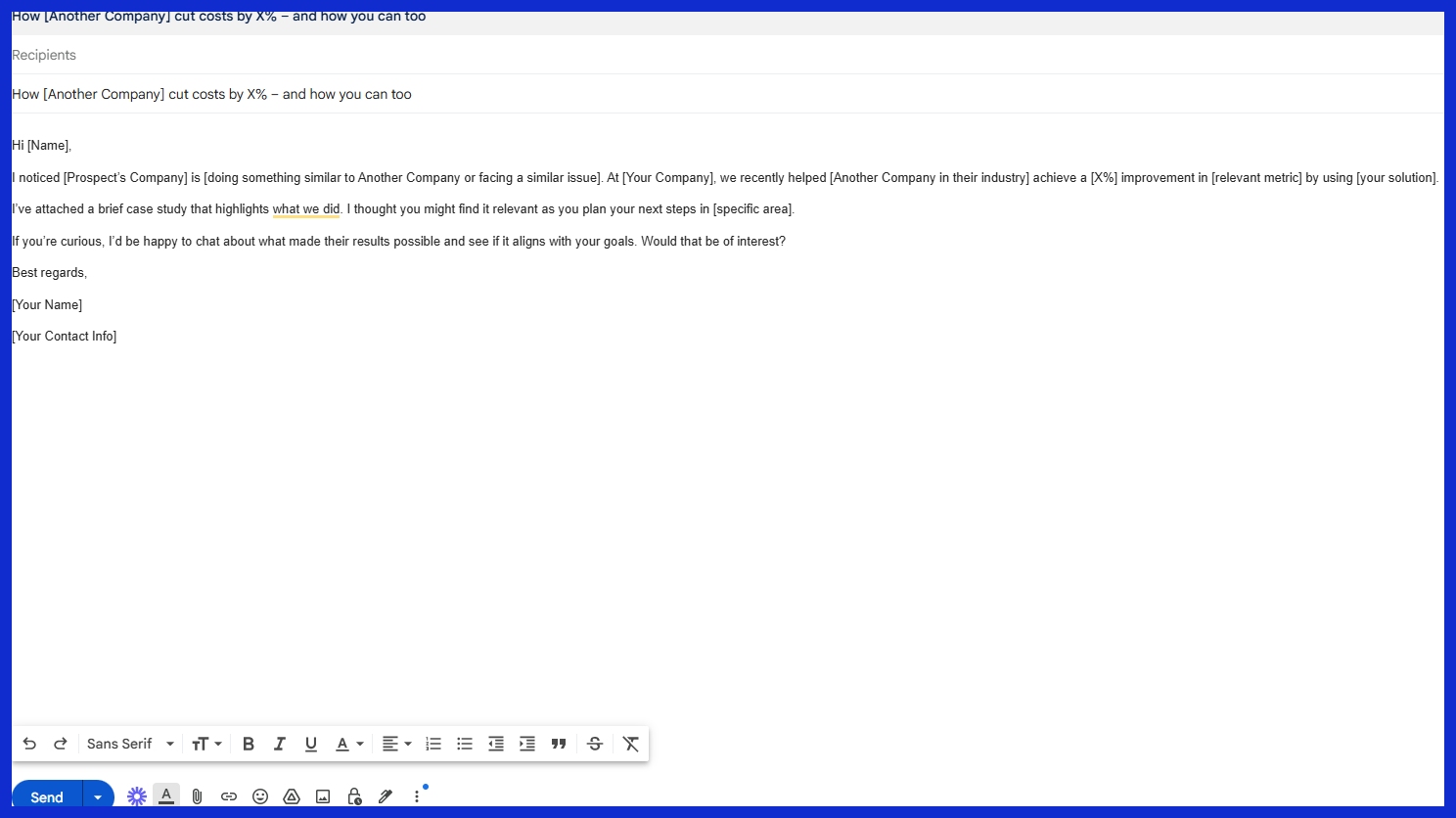
Subject: How [Another Company] cut costs by X% – and how you can too
Hi [Name],
I noticed [Prospect’s Company] is [doing something similar to Another Company or facing a similar issue]. At [Your Company], we recently helped [Another Company in their industry] achieve a [X%] improvement in [relevant metric] by using [your solution].
I’ve attached a brief case study that highlights what we did. I thought you might find it relevant as you plan your next steps in [specific area].
If you’re curious, I’d be happy to chat about what made their results possible and see if it aligns with your goals. Would that be of interest?
Best regards,
[Your Name]
[Your Contact Info]
Why it works: People trust real results. This email leads with a quick success story involving a known company or one like theirs. Sharing a one-page case study (or summarizing it) provides concrete evidence of value. It shows you have experience in their industry or challenge. The focus is on “what you can achieve,” so the prospect naturally wonders if those gains could apply to them.
8. Product Demo Invitation
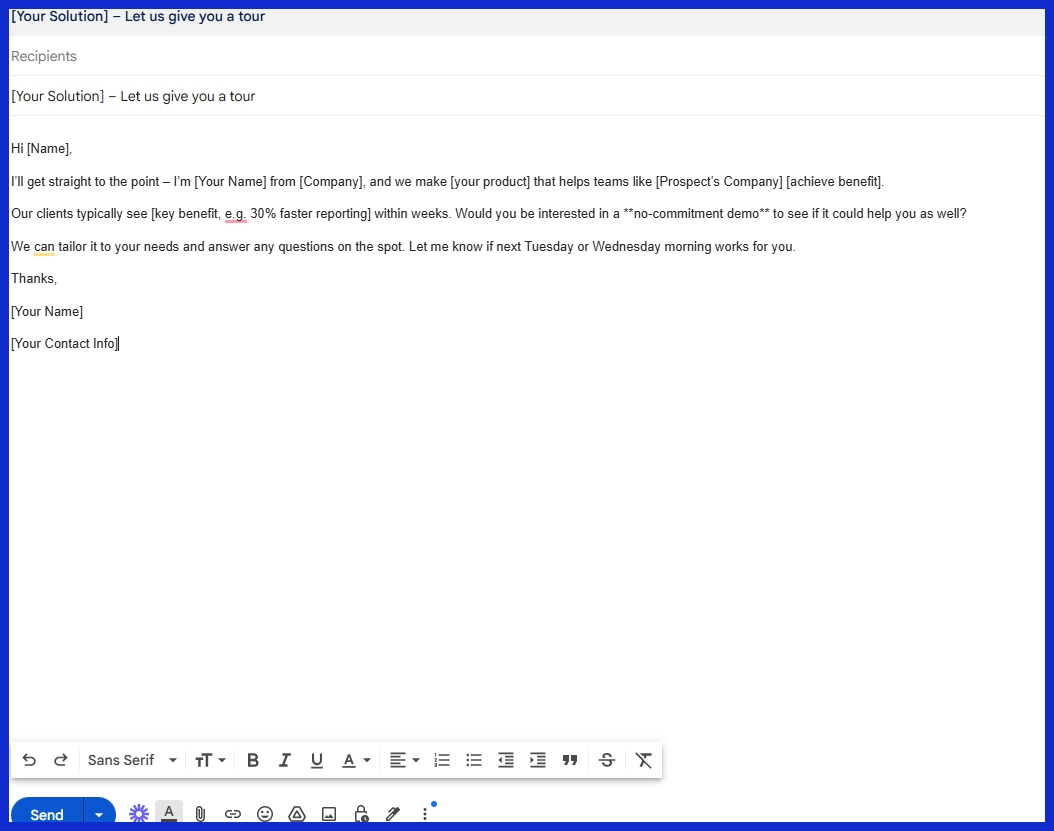
Subject: [Your Solution] – Let us give you a tour
Hi [Name],
I’ll get straight to the point – I’m [Your Name] from [Company], and we make [your product] that helps teams like [Prospect’s Company] [achieve benefit].
Our clients typically see [key benefit, e.g. 30% faster reporting] within weeks. Would you be interested in a **no-commitment demo** to see if it could help you as well?
We can tailor it to your needs and answer any questions on the spot. Let me know if next Tuesday or Wednesday morning works for you.
Thanks,
[Your Name]
[Your Contact Info]
Why it works: This is a straightforward demo ask. Because you’ve mentioned a clear benefit (e.g., “30% faster reporting”), the demo feels like a helpful offer rather than a cold pitch. Using words like “get a tour” and “no-commitment demo” lowers pressure. You also suggest specific times, making it easy for them to agree without back-and-forth.
9. Content Follow-Up (e.g., After They Downloaded Something)
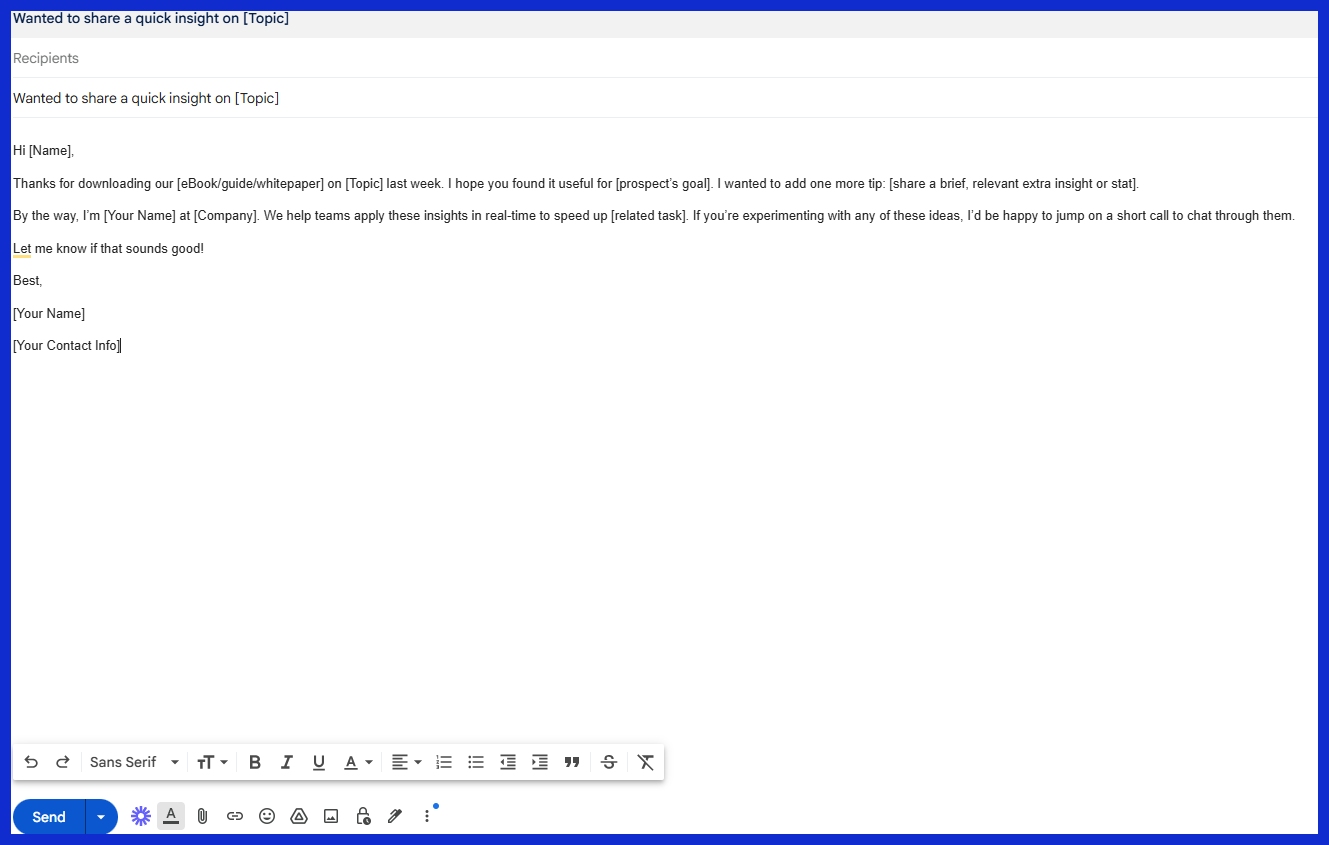
Subject: Wanted to share a quick insight on [Topic]
Hi [Name],
Thanks for downloading our [eBook/guide/whitepaper] on [Topic] last week. I hope you found it useful for [prospect’s goal]. I wanted to add one more tip: [share a brief, relevant extra insight or stat].
By the way, I’m [Your Name] at [Company]. We help teams apply these insights in real-time to speed up [related task]. If you’re experimenting with any of these ideas, I’d be happy to jump on a short call to chat through them.
Let me know if that sounds good!
Best,
[Your Name]
[Your Contact Info]
Why it works: This follows up on something the prospect already showed interest in. Mentioning their download (or webinar signup, etc.) is a natural conversation starter. You add extra value (a quick tip) so it’s not just a sales pitch. You also remind them who you are, linking your help to the content they just engaged with. It’s a warm touchpoint, so replies are more likely.
10. Company News or Milestone (Congratulatory Intro)

Subject: Congratulations on [Company News/Achievement]!
Hi [Name],
I noticed [Prospect’s Company] recently [launched a new product/raised funding/won an award]. Congrats to you and your team on that milestone!
I’m [Your Name] at [Your Company]. We’ve worked with similar growing companies in [industry] to [achieve X, e.g. streamline operations or enter new markets]. If you’re tackling [related challenge] as part of this expansion, I’d love to share how we can help.
Can I send over a quick overview or set up a 10-minute chat?
Cheers,
[Your Name]
[Your Contact Info]
Why it works: Starting with a sincere congratulations or acknowledgment of good news shows you’re paying attention and care about their success. It makes the email feel celebratory rather than salesy. This positive tone opens the door to talking about helping them build on that success, rather than selling to them out of the blue.
11. Seasonal or Event Tie-In

Subject: [Season] plans at [Prospect’s Company]?
Hi [Name],
As [season/quarter/year] comes around, many [industry] teams are planning for [upcoming event or trend]. I’m [Your Name] at [Company], and I thought you might like a quick tip we’ve shared with clients: [one-sentence tip relevant to the season].
We’ve seen it help companies like [Name] avoid [specific problem] during this busy time. Do you have a few minutes next week to discuss strategies for [prospect’s seasonal goal]? If not, no worries at all.
All the best,
[Your Name]
[Your Contact Info]
Why it works: This frames your outreach in a timely context (e.g. end-of-year planning, holiday rush, industry conference). By linking to something on the prospect’s calendar, your email feels more relevant and less random. The shared tip demonstrates expertise, and the light CTA acknowledges they might be busy.
12. Follow-Up After Previous Contact (Nudge)

Subject: Following up on my last email
Hi [Name],
Just checking in – I emailed last week about [topic/offer], and I wanted to make sure it didn’t get buried. I know how busy things can be.
Quick recap: I’m [Your Name] at [Company], and we [solve X problem] for companies like [Prospect’s Company]. I thought [specific benefit or insight] could really help you.
If now isn’t a good time, I understand. Would you be open to a brief chat later this month? Even just a quick yes/no would help me out.
Thanks for your time,
[Your Name]
[Your Contact Info]
Why it works: This is a polite follow-up that assumes the email was missed rather than ignored. It’s short and gives a quick summary to remind them why you reached out. By explicitly saying “a quick yes/no would help,” you lower the friction for a reply. Even if they aren’t interested, a one-line reply saves you guessing.
13. Industry Insight or Trend Lead

Subject: Thought you’d find this industry stat interesting
Hi [Name],
I came across an interesting stat about [industry trend or challenge] today and immediately thought of you: “[insert relevant stat or finding].” At [Your Company], we’ve been helping [industry] teams respond by [brief description of solution].
For example, our clients often see [result] by addressing exactly this trend. If you’re looking at [trend] at [Prospect’s Company], I’d be happy to share what we’ve learned.
Let me know if you’d like to chat!
Best wishes,
[Your Name]
[Your Contact Info]
Why it works: Leveraging a timely industry fact shows you’re tuned in and adds immediate value. It grabs attention (“a stat you’d find interesting”) and provides a reason to care. This email is less about you and more about helping them stay informed. After sharing the insight, you briefly position your solution as part of the response, which justifies the conversation.
14. New Feature/Product Announcement (Soft Intro)

Subject: Just released: [New Feature/Product] that [solves X]
Hi [Name],
I hope you’re doing well. I wanted to share some news: we just launched [New Feature/Product] at [Your Company], designed to [brief benefit]. It’s something I thought might interest [Prospect’s Company], given your focus on [relevant area].
If you’d like a quick demo of what it does, let me know. Otherwise, I’ll send along a short overview that you can review at your convenience.
Thanks,
[Your Name]
[Your Contact Info]
Why it works: People are curious about new tools, especially if it sounds directly relevant. This email combines news with an offer. It doesn’t immediately ask for a meeting; it offers a demo or just info, so the prospect can choose an easy next step. This softer tone can feel like a helpful update rather than a sales push.
15. Complementary Resource (Partner/Congratulation Email)

Subject: [Resource] for your team at [Prospect’s Company]
Hi [Name],
Congrats on [recent achievement or known challenge]! At [Your Company], we’ve faced similar situations with our clients. We actually put together a quick checklist/guide on [related task], and I thought it could help your team too. Here it is: [Link or attachment].
No strings attached – just wanted to pass along something useful. If you’d ever like to discuss how we helped other companies overcome [related challenge], I’d be happy to chat.
Warm regards,
[Your Name]
[Your Contact Info]
Why it works: This is akin to a referral or congratulatory approach, but focused on providing a specific resource. It starts with a positive note and a genuinely useful link. The “no strings attached” phrasing reinforces that you’re not immediately asking for money. It positions you as someone supportive, which can prompt a thank-you reply or future interest.
Crafting Your Sales Introduction Email Template

On making a sales intro email template: Simple to use, brief, and recipient-centered. Be clear and concise, as most prospects receive a large number of emails every day. Hit their reply button by being between 50 and 125 words, structured, and personal. Templates save time and ensure that each message adheres to the same best practices.
The most effective sales introduction emails have these key components:
-
Short, direct subject line (about five words)
-
Personalized greeting
-
Clear statement of purpose
-
Brief value proposition
-
Proof or credibility
-
Simple call-to-action
Avoiding Common Introduction Pitfalls

A sales introduction email is usually where you start establishing trust with a new prospect. This initial point of contact influences decision-makers’ perception of you and your proposal. There are more common introduction pitfalls than you think, which can dilute the power of your email, making your outreach less likely to score a reply or a deal.
Some common pitfalls include:
-
Employing ambiguous or hackneyed headline-like subjects that don’t pop
-
Writing long, dense paragraphs that overwhelm or bore recipients
-
Over-selling your product in the intro vs. being recipient-centric
-
Using jargon, buzzwords, or overly technical language that confuses
-
Sounding too aggressive or pushy in your sales approach
-
Sending the same template to every prospect without personalizing
-
Not optimizing for mobile, making your emails a pain to read on phones
-
Not demonstrating any research or understanding of the recipient’s business
-
Lacking a clear call to action or next step
Conclusion
A good sales introduction email is short, clear, and personal. Start with a strong subject line and opening line that grabs attention. Show the prospect you understand what matters to them, and keep the tone friendly—like a real conversation, not a pitch.
Add specifics, share a little proof, and finish with one simple call-to-action. Nobody wants to read a long, pushy email. The shorter and more relevant you make it, the more replies you’ll get.
Don’t forget to test different approaches and see what works best. Tools like KPI.me can help you track results and spot patterns, so your team keeps getting better with every email.
Keep it human, keep it simple, and you’ll turn more introductions into real conversations.
Frequently Asked Questions
What is a sales introduction email?
An introductory email serves as a powerful tool to introduce yourself and your business to a prospective client, aiming to initiate a business relationship and generate interest in your product or service.
How do I write an effective sales introduction email?
Make your introductory email easy and quick to read. Personalize it by mentioning the prospective client’s needs and offering to solve them. Don’t forget your call to action.
Why is personalization important in sales emails?
Personalization in your business introduction email demonstrates that you know the reader’s needs, making it more likely your email outreach will be successful.
What should I avoid in a sales introduction email?
Craft a concise business introduction email that respects the recipient’s time, avoiding buzzwords and ambiguity.
How can I increase the reply rate to my sales introduction emails?
Write an eye-catching subject for your introductory email and always close with a warm, action-oriented question.
Are templates helpful for sales introduction emails?
Yes, using sales email templates is time-saving and assures consistency in your email outreach.
How many follow-up emails should I send after the introduction?
If you don’t get a response to your business introduction email, send one or two polite follow-ups spaced a couple of days apart, keeping each message short and courteous.

